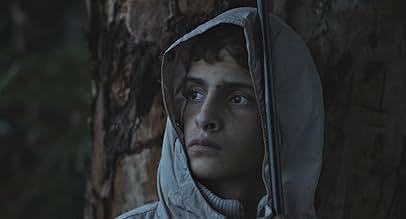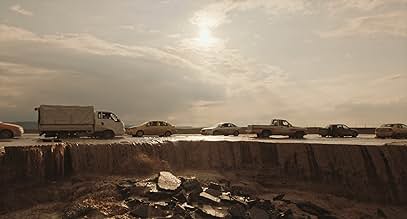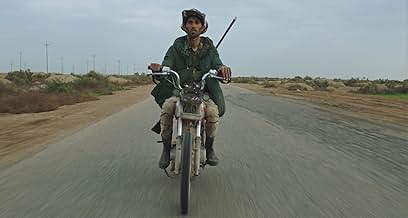CALIFICACIÓN DE IMDb
6.6/10
1.4 k
TU CALIFICACIÓN
Un documental sobre los que intentan sobrevivir en un Oriente Medio devastado por la guerra.Un documental sobre los que intentan sobrevivir en un Oriente Medio devastado por la guerra.Un documental sobre los que intentan sobrevivir en un Oriente Medio devastado por la guerra.
- Dirección
- Guionista
- Premios
- 7 premios ganados y 15 nominaciones en total
Opiniones destacadas
Nice images without context. These could have been observed anywhere, with or without a war or other threats around. Did I not have similar problems with Fire At Sea / Fuocoammare at Berlinale 2016?? My first thoughts at the time were that I saw nothing new and revolutionary. Other attendees made me doubt, however. The reactions of people around me forced me to re-think what impact such a documentary can have on the average viewer, apparently on them. What did I miss??
I've seen many documentaries around the same topic in 2016/2017, which causes a certain distance and some feeling that all this should be common knowledge already. Still, images like this seem to impress people. Maybe it showcases the term "impressionistic" I see in many reviews, something that I did not understand when explained at school, and still goes above my head nowadays. Viewers knowledgeable about the context seem able to connect the dots when letting these images pass by. I wonder how it would be received by someone who was not told beforehand what the central topic of conversation was.
Some of the images (1/3 as I mentioned before) can be understood without context, like the women mourning in a prison cell, the soldiers jogging/marching at dawn, soldiers surveying the environment from a shelter, stage players practicing their lines (quoting clear texts about the sorry state of their country), school children explaining their drawings, and so on. Those parts really were memorable. The other 2/3 went past me.
I sat it out through the end, but still do not understand the value of this documentary (if any). Maybe I just don't like kaleidoscopic movies, presenting a series of images/scenes that are not related to each other, not telling a story but merely painting an image where we are pressured to connect the dots and understand what the filmmakers try to convey. It is lost on me, in any case. Another explanation can be that I saw so many documentaries (part of IDFA, Movies That Matter, and other festivals) that are so much more illuminating and compelling, that this one in comparison does very little to pique my interest. It tells nothing new, and just repeats the obvious in a slightly different way but not adding any value. Leaves us with the nice images.
I've seen many documentaries around the same topic in 2016/2017, which causes a certain distance and some feeling that all this should be common knowledge already. Still, images like this seem to impress people. Maybe it showcases the term "impressionistic" I see in many reviews, something that I did not understand when explained at school, and still goes above my head nowadays. Viewers knowledgeable about the context seem able to connect the dots when letting these images pass by. I wonder how it would be received by someone who was not told beforehand what the central topic of conversation was.
Some of the images (1/3 as I mentioned before) can be understood without context, like the women mourning in a prison cell, the soldiers jogging/marching at dawn, soldiers surveying the environment from a shelter, stage players practicing their lines (quoting clear texts about the sorry state of their country), school children explaining their drawings, and so on. Those parts really were memorable. The other 2/3 went past me.
I sat it out through the end, but still do not understand the value of this documentary (if any). Maybe I just don't like kaleidoscopic movies, presenting a series of images/scenes that are not related to each other, not telling a story but merely painting an image where we are pressured to connect the dots and understand what the filmmakers try to convey. It is lost on me, in any case. Another explanation can be that I saw so many documentaries (part of IDFA, Movies That Matter, and other festivals) that are so much more illuminating and compelling, that this one in comparison does very little to pique my interest. It tells nothing new, and just repeats the obvious in a slightly different way but not adding any value. Leaves us with the nice images.
Several years ago, Gianfranco Rosi lectured to an audience of university students (myself included) about his next project: it would be filmed exclusively at night, he said, and take place over much of the Middle East. He asked that we not release any of this information - assured of the secret pact with his audience. I had more or less forgotten about this project until recently, when I discovered it had been selected as the Italian entry for the Best International Feature Film at the 93rd Academy Awards, and was being distributed by MUBI.
Notturno ("night," or "of the night") is a collection of brief glimpses into the lives of people across Syria, Lebanon, Iraq and the Kurdistan region of northern Iraq. From dark swamplands to inner cities, fisherman, soldiers and teachers, to name a few, are brought into the documentary's compass. Few words are spoken by those selected, and much of their action or routine takes place in quietness - a sort of calm in the aftermath of a terrible storm. Rosi's observational and distant study only partly takes places at night; many scenes are filmed in the soft glow of dawn or twilight, and many in bright sunlight.
For a while, I was sceptical about the documentary's artistic license. There is near-perfect composition to each frame, and the theatrical recreation of war by the amateur, psychiatric patients reminded me of Joshua Oppenheimer's The Act of Killing (where civilians and dictators are made to dramatise the traumas of their past). And yet, I found myself compelled by Notturno's visual storytelling, by the sparseness of its landscapes and sound. There are stories within these images, and sometimes they need to speak for themselves, without the aid of conventional narration or voiceover.
Notturno ("night," or "of the night") is a collection of brief glimpses into the lives of people across Syria, Lebanon, Iraq and the Kurdistan region of northern Iraq. From dark swamplands to inner cities, fisherman, soldiers and teachers, to name a few, are brought into the documentary's compass. Few words are spoken by those selected, and much of their action or routine takes place in quietness - a sort of calm in the aftermath of a terrible storm. Rosi's observational and distant study only partly takes places at night; many scenes are filmed in the soft glow of dawn or twilight, and many in bright sunlight.
For a while, I was sceptical about the documentary's artistic license. There is near-perfect composition to each frame, and the theatrical recreation of war by the amateur, psychiatric patients reminded me of Joshua Oppenheimer's The Act of Killing (where civilians and dictators are made to dramatise the traumas of their past). And yet, I found myself compelled by Notturno's visual storytelling, by the sparseness of its landscapes and sound. There are stories within these images, and sometimes they need to speak for themselves, without the aid of conventional narration or voiceover.
If you aren't blown away by the power of this maybe just stick to Hollywood CGI'd blockbusters. The lack of narration adds power to the heartbreaking stories of ordinary peoples lives in dire situations. If you're expecting to be spoon fed a happy ending just move on this isn't for you, reflection, empathy and questioning the status quo requires intelligence.
Gianfranco Rosi's follow-up to FIRE AT SEA which was about Middle-Eastern and North African migrants coming ashore on a small Italian island. NOTTURNO depicts the circumstances by which many of those refugees come to be. Whether it's Iraq, Kurdistan, Syria or Lebanon Rosi's camera simply captures the lives caught up in the turmoil.
Rosi's Documentary is naturalistic. There is no narration. No title cards. No manipulative music. There's even very little in the way of conversation. Whether it be an all female military troop, a teenage hunter, a group staging a political play, elderly mourners or, most chillingly, a group of school children recounting in words and drawings the horrors of ISIS, Rosi's camera is simply there to record.
The cinematography and sound work is extraordinary, but, they never call undue attention upon themselves. A little familiarity with the wars and political strife that have occurred in the region is helpful. Rosi provides vivid images and audio, but he leaves it to the viewer to provide their own insight. It's a fine achievement.
This movie sucks it's so boring. I could've done a better documentary with my android phone.
¿Sabías que…?
- TriviaOfficial submission of Italy for the 'Best International Feature Film' category of the 93rd Academy Awards in 2021.
- Citas
Teacher: Tell me what you saw.
Selecciones populares
Inicia sesión para calificar y agrega a la lista de videos para obtener recomendaciones personalizadas
- How long is Notturno?Con tecnología de Alexa
Detalles
Taquilla
- Total a nivel mundial
- USD 121,053
- Tiempo de ejecución
- 1h 40min(100 min)
- Color
- Relación de aspecto
- 1.85 : 1
Contribuir a esta página
Sugiere una edición o agrega el contenido que falta


![Trailer [OV]](https://m.media-amazon.com/images/M/MV5BNzY2YTkyZGQtOWYwOS00MDRhLWEyZDctNWU0MGE2YzdmOGEwXkEyXkFqcGdeQXRyYW5zY29kZS13b3JrZmxvdw@@._V1_QL75_UX500_CR0)


















